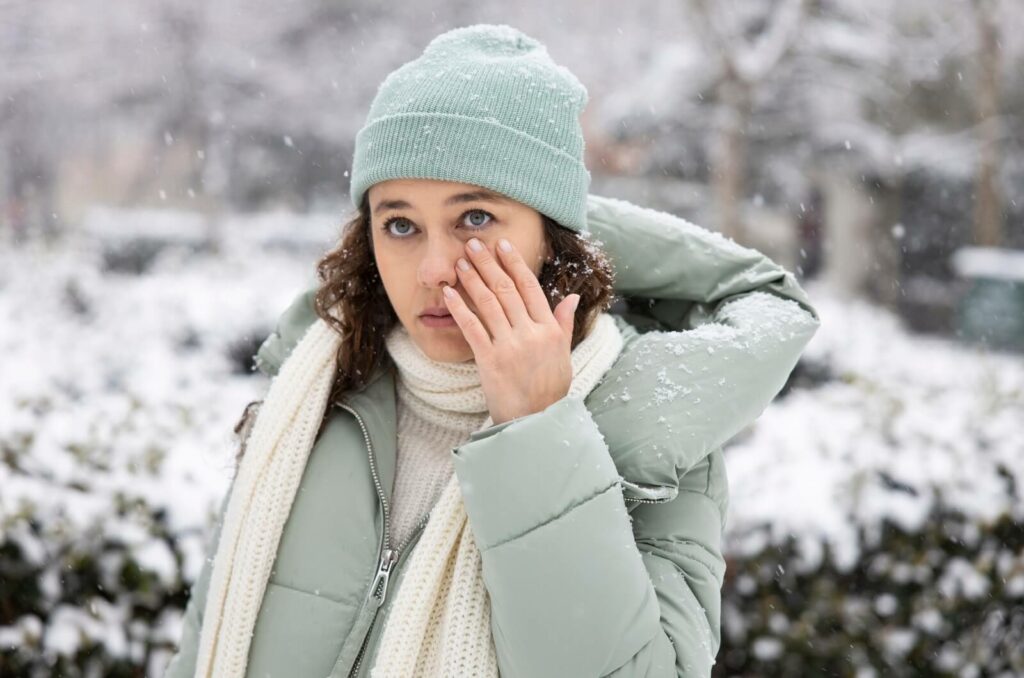Dry eye syndrome is a widespread condition that affects millions. Dry eye is often more prevalent during the colder winter months, when environmental factors can exacerbate symptoms, which include stinging sensation or feeling like something is in your eyes.
As indoor heating systems and harsh winter winds strip away moisture, understanding this condition becomes crucial for those seeking relief from the discomfort and potential vision problems that dry eye can cause.
Your eye doctor can help you find relief if you’re still experiencing symptoms after trying a home remedy like eye drops or warm compresses.
Understanding Dry Eye
Dry eye syndrome occurs when your eyes don’t produce enough tears or your tears evaporate too quickly. This condition can lead to discomfort and even vision problems. You may notice that you’re experiencing symptoms more often in the dry winter Alberta months.
Dry eye is often little more than a minor irritation and is easily relieved with over-the-counter (OTC) and at-home remedies. But it can also be a chronic condition that requires ongoing treatment.
In particular, because untreated dry eye can result in severe complications like corneal ulcers or the inability to wear contact lenses, it’s important to consult your eye doctor about untreated or persistent dry eye.
Symptoms of Dry Eye
Dry eye symptoms can include:
- A stinging, burning, or scratchy sensation in your eyes
- Stringy mucus in or around your eyes
- Eye fatigue
- Sensitivity to light
- Redness in the eyes
- A sensation of having something in your eyes
- Difficulty wearing contact lenses
- Blurred vision
Causes of Dry Eye
The causes of dry eye are as diverse as its symptoms. Some common causes and risk factors include:
- Age
- Contact lens use
- Screen time
- Environmental conditions
- Medical conditions
Why Dry Eyes Are More Common in Winter
Have you ever wondered why your eyes feel worse in the winter? The answer lies in both indoor and outdoor conditions unique to the season. Indoor heating systems may keep you warm, but they also reduce humidity levels, leading to drier air. This low humidity can quickly sap the moisture from your eyes, leaving them feeling parched.
Outdoor conditions also play a role. Cold, windy weather can cause tears to evaporate more quickly than usual. Additionally, winter winds can blow debris into your eyes, further irritating them.
Understanding these environmental factors can help you take proactive measures to protect your eyes.
Tips for Preventing Dry Eyes in Winter
Prevention is better than a cure, especially when it comes to dry eyes. One effective strategy is to use a humidifier in your home. This can help maintain indoor humidity levels, ensuring the air doesn’t dry out your eyes.

Staying hydrated is another crucial tip. Drinking plenty of water helps maintain tear production, which is essential for keeping your eyes moist. Make it a habit to carry a water bottle with you, even in the colder months.
Finally, try to limit your screen time. Prolonged exposure to screens can cause your eyes to blink less frequently, leading to dryness and digital eye strain. To mitigate this effect, follow the 20-20-20 rule—every 20 minutes, look at something 20 feet away for at least 20 seconds.
OTC & Medical Treatment Options
If prevention methods aren’t enough, there are several treatment options available. OTC artificial tears can provide immediate relief by lubricating the eyes. Warm compresses can also be beneficial and soothing.
For more severe cases, prescription medications may be necessary. Your eye doctor might recommend anti-inflammatory eye drops or medications that help increase tear production. In some cases, your eye doctor may recommend punctal plugs or other in-office treatments like IPL.
Lifestyle Adjustments for Long-Term Management
Managing dry eyes typically requires more than immediate fixes—lifestyle changes can also have significant impacts. Start by wearing sunglasses when you’re outside, as these can act as a barrier against wind and debris, reducing irritation. Choose wraparound styles for maximum protection.
Consider making dietary adjustments as well. Foods rich in omega-3 fatty acids, like salmon and flaxseeds, may help improve tear quality. Supplements are also an option if you find getting enough omega-3s from your diet challenging.
Regular exercise can also help. Physical activity improves circulation, which can benefit tear production. Aim for at least 30 minutes of moderate exercise most days of the week. Whether it’s a brisk walk or a yoga session, staying active can contribute to overall eye health.
Discuss Your Dry Eyes with Your Eye Doctor
Understanding and managing dry eye syndrome requires a comprehensive approach that considers its symptoms, diverse causes, and the heightened challenges the winter season presents.
Prioritizing eye care, especially in the winter months, can help individuals maintain optimal vision and comfort and enhance their overall quality of life. Call our team at Eye Effects and schedule an appointment with one of our experienced eye doctors. We can examine your eyes, discuss your symptoms, and offer tailored prevention and treatment advice.


